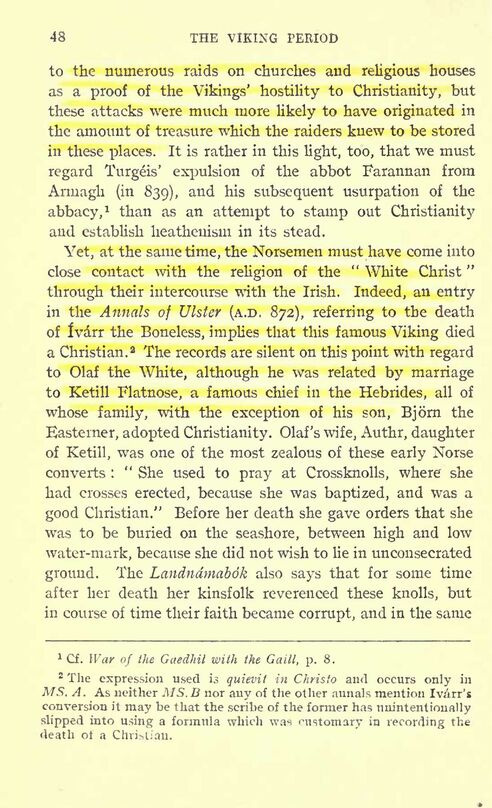
Full resolution (JPEG) - On this page / på denna sida - VII. The Vikings and the Celtic Church

<< prev. page << föreg. sida << >> nästa sida >> next page >>
Below is the raw OCR text
from the above scanned image.
Do you see an error? Proofread the page now!
Här nedan syns maskintolkade texten från faksimilbilden ovan.
Ser du något fel? Korrekturläs sidan nu!
This page has never been proofread. / Denna sida har aldrig korrekturlästs.
48 THE VIKING PERIOD
to the numerous raids on churches and religious houses
as a proof of the Vikings’ hostility to Christianity, but
these attacks were much more likely to have originated in
the amount of treasure which the raiders knew to be stored
in these places. It is rather in this light, too, that we must
regard Turgeis’ expulsion of the abbot Farannan from
Armagh (in 839), and his subsequent usurpation of the
abbacy,
1
than as an attempt to stamp out Christianity
and establish heathenism in its stead.
Yet, at the same time, the Norsemen must have come into
close contact with the religion of the
"
White Christ
"
through their intercourse with the Irish. Indeed, an entry
in the Annals of Ulster (A.D. 872), referring to the death
of Ivdrr the Boneless, implies that this famous Viking died
a Christian. 2
The records are silent on this point with regard
to Olaf the White, although he was related by marriage
to Ketill Flatnose, a famous chief in the Hebrides, all of
whose family, with the exception of his son, Bjora the
Easterner, adopted Christianity. Olaf’s wife, Authr, daughter
of Ketill, was one of the most zealous of these early Norse
converts :
"
She used to pray at Crossknolls, where she
had crosses erected, because she was baptized, and was a
good Christian." Before her death she gave orders that she
was to be buried on the seashore, between high and low
water-mark, because she did not wish to lie in unconsecrated
ground. The Landndmabok also says that for some time
after her death her kinsfolk reverenced these knolls, but
in course of time their faith became corrupt, and in the same
1
Cf. War of the Gaedhil with the Gaill, p. 8.
2
The expression used is quievit in Christo and occurs only in
MS. A . As neither MS. B nor any of the other annals mention Iv4rr’s
conversion it may be that the scribe of the former has unintentionally
slipped into using a formula which was customary in recording the
death ot a Christian.
<< prev. page << föreg. sida << >> nästa sida >> next page >>